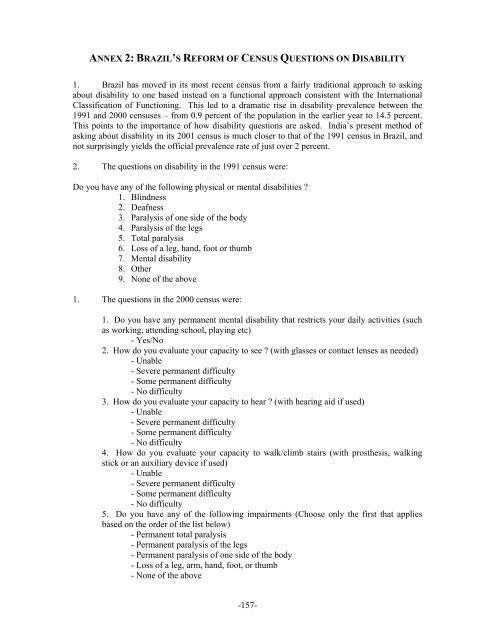People with Disabilities in India: From Commitment to Outcomes
People with Disabilities in India: From Commitment to Outcomes
People with Disabilities in India: From Commitment to Outcomes
You also want an ePaper? Increase the reach of your titles
YUMPU automatically turns print PDFs into web optimized ePapers that Google loves.
ANNEX 2: BRAZIL’S REFORM OF CENSUS QUESTIONS ON DISABILITY<br />
1. Brazil has moved <strong>in</strong> its most recent census from a fairly traditional approach <strong>to</strong> ask<strong>in</strong>g<br />
about disability <strong>to</strong> one based <strong>in</strong>stead on a functional approach consistent <strong>with</strong> the International<br />
Classification of Function<strong>in</strong>g. This led <strong>to</strong> a dramatic rise <strong>in</strong> disability prevalence between the<br />
1991 and 2000 censuses – from 0.9 percent of the population <strong>in</strong> the earlier year <strong>to</strong> 14.5 percent.<br />
This po<strong>in</strong>ts <strong>to</strong> the importance of how disability questions are asked. <strong>India</strong>’s present method of<br />
ask<strong>in</strong>g about disability <strong>in</strong> its 2001 census is much closer <strong>to</strong> that of the 1991 census <strong>in</strong> Brazil, and<br />
not surpris<strong>in</strong>gly yields the official prevalence rate of just over 2 percent.<br />
2. The questions on disability <strong>in</strong> the 1991 census were:<br />
Do you have any of the follow<strong>in</strong>g physical or mental disabilities ?<br />
1. Bl<strong>in</strong>dness<br />
2. Deafness<br />
3. Paralysis of one side of the body<br />
4. Paralysis of the legs<br />
5. Total paralysis<br />
6. Loss of a leg, hand, foot or thumb<br />
7. Mental disability<br />
8. Other<br />
9. None of the above<br />
1. The questions <strong>in</strong> the 2000 census were:<br />
1. Do you have any permanent mental disability that restricts your daily activities (such<br />
as work<strong>in</strong>g, attend<strong>in</strong>g school, play<strong>in</strong>g etc)<br />
- Yes/No<br />
2. How do you evaluate your capacity <strong>to</strong> see ? (<strong>with</strong> glasses or contact lenses as needed)<br />
- Unable<br />
- Severe permanent difficulty<br />
- Some permanent difficulty<br />
- No difficulty<br />
3. How do you evaluate your capacity <strong>to</strong> hear ? (<strong>with</strong> hear<strong>in</strong>g aid if used)<br />
- Unable<br />
- Severe permanent difficulty<br />
- Some permanent difficulty<br />
- No difficulty<br />
4. How do you evaluate your capacity <strong>to</strong> walk/climb stairs (<strong>with</strong> prosthesis, walk<strong>in</strong>g<br />
stick or an auxiliary device if used)<br />
- Unable<br />
- Severe permanent difficulty<br />
- Some permanent difficulty<br />
- No difficulty<br />
5. Do you have any of the follow<strong>in</strong>g impairments (Choose only the first that applies<br />
based on the order of the list below)<br />
- Permanent <strong>to</strong>tal paralysis<br />
- Permanent paralysis of the legs<br />
- Permanent paralysis of one side of the body<br />
- Loss of a leg, arm, hand, foot, or thumb<br />
- None of the above<br />
-157-










